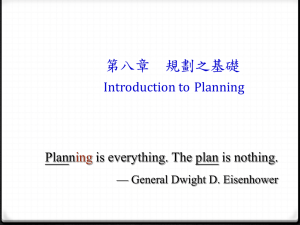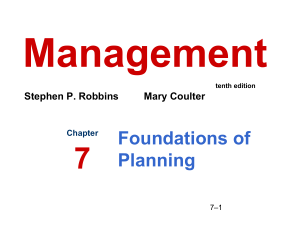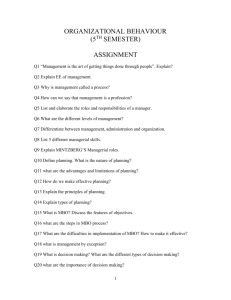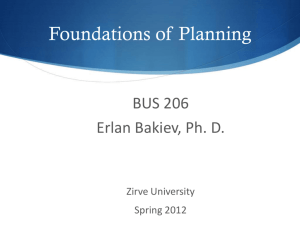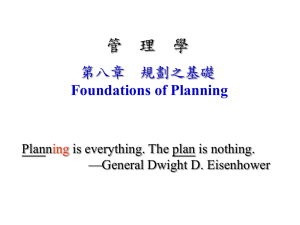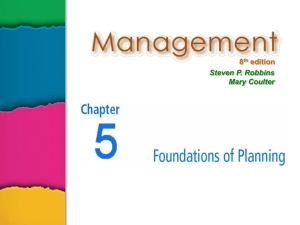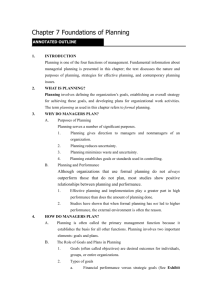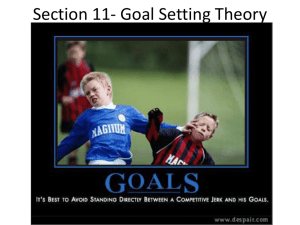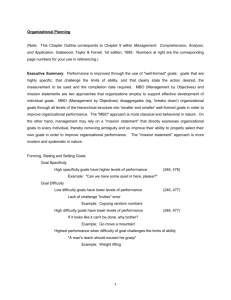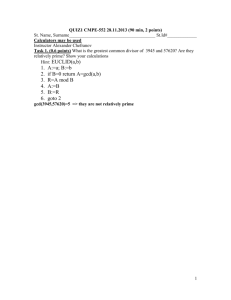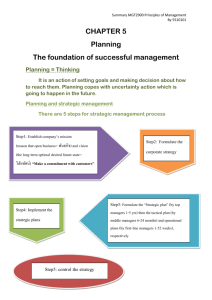Foundations of Planning and Strategic Management
advertisement
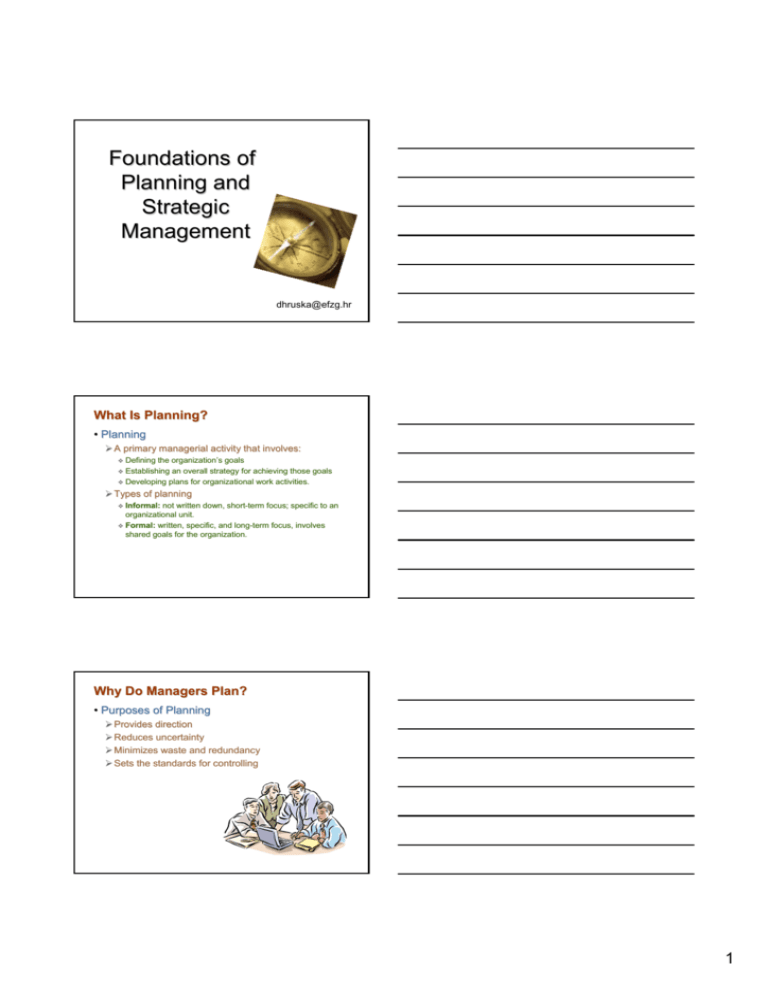
Foundations of Planning and Strategic Management dhruska@efzg.hr What Is Planning? • Planning ¾ A primary managerial activity that involves: Defining the organization’ organization’s goals an overall strategy for achieving those goals Developing plans for organizational work activities. Establishing ¾ Types of planning Informal: not written down, shortshort-term focus; specific to an organizational unit. Formal: written, specific, and longlong-term focus, involves shared goals for the organization. Why Do Managers Plan? • Purposes of Planning ¾ Provides direction ¾ Reduces uncertainty ¾ Minimizes waste and redundancy ¾ Sets the standards for controlling 1 Planning and Performance • The Relationship Between Planning And Performance ¾ Formal planning is associated with: Higher profits and returns on assets. Positive financial results. ¾ The quality of planning and implementation affects performance more than the extent of planning. ¾ The external environment can reduce the impact of planning on performance, ¾ Formal planning must be used for several years before planning begins to affect performance. How Do Managers Plan? • Elements of Planning ¾ Goals Desired outcomes for individuals, groups, or entire organizations Provide direction and evaluation performance criteria ¾ Plans Documents that outline how goals are to be accomplished Describe how resources are to be allocated and establish activity schedules Types of Goals • Financial Goals ¾ Are related to the expected internal financial performance of the organization. • Strategic Goals ¾ Are related to the performance of the firm relative to factors in its external environment (e.g., competitors). • Stated Goals versus Real Goals ¾ BroadlyBroadly-worded official statements of the organization (intended for public consumption) that may be irrelevant to its real goals (what actually goes on in the organization). 2 Types of Plans Types of Plans • Strategic Plans ¾ Apply to the entire organization. ¾ Establish the organization’ organization’s overall goals. ¾ Seek to position the organization in terms of its environment. ¾ Cover extended periods of time. • Operational Plans ¾ Specify the details of how the overall goals are to be achieved. ¾ Cover short time period. Types of Plans (cont’ (cont’d) • LongLong-Term Plans ¾ Plans with time frames extending beyond three years • ShortShort-Term Plans ¾ Plans with time frames on one year or less • Specific Plans ¾ Plans that are clearly defined and leave no room for interpretation • Directional Plans ¾ Flexible plans that set out general guidelines, provide focus, yet allow discretion in implementation. 3 Specific Versus Directional Plans Types of Plans (cont’ (cont’d) • SingleSingle-Use Plan ¾ A oneone-time plan specifically designed to meet the need of a unique situation. • Standing Plans ¾ Ongoing plans that provide guidance for activities performed repeatedly. Establishing Goals and Developing Plans • Traditional Goal Setting ¾ Broad goals are set at the top of the organization. ¾ Goals are then broken into subgoals for each organizational level. ¾ Assumes that top management knows best because they can see the “big picture.” picture.” ¾ Goals are intended to direct, guide, and constrain from above. ¾ Goals lose clarity and focus as lowerlower-level managers attempt to interpret and define the goals for their areas of responsibility. 4 Establishing Goals and Developing Plans (cont’ (cont’d) • Maintaining the Hierarchy of Goals ¾ Means– Means–Ends Chain The integrated network of goals that results from establishing a clearlyclearly-defined hierarchy of organizational goals. Achievement of lowerlower-level goals is the means by which to reach higherhigher-level goals (ends). Establishing Goals and Developing Plans (cont’ (cont’d) • Management By Objectives (MBO) ¾ Specific performance goals are jointly determined by employees and managers. ¾ Progress toward accomplishing goals is periodically reviewed. ¾ Rewards are allocated on the basis of progress towards the goals. ¾ Key elements of MBO: Goal specificity, participative decision making, an explicit performance/evaluation period, feedback Steps in a Typical MBO Program 1. The organization’s overall objectives and strategies are formulated. 2. Major objectives are allocated among divisional and departmental units. 3. Unit managers collaboratively set specific objectives for their units with their managers. 4. Specific objectives are collaboratively set with all department members. 5. Action plans, defining how objectives are to be achieved, are specified and agreed upon by managers and employees. 6. The action plans are implemented. 7. Progress toward objectives is periodically reviewed, and feedback is provided. 8. Successful achievement of objectives is reinforced by performance-based rewards. 5 Does MBO Work? • Reason for MBO Success ¾ Top management commitment and involvement • Potential Problems with MBO Programs ¾ Not as effective in dynamic environments that require constant resetting of goals. ¾ Overemphasis on individual accomplishment may create problems with teamwork. ¾ Allowing the MBO program to become an annual paperwork shuffle. Characteristics of WellWell-Designed Goals • Written in terms of outcomes, not actions • Challenging yet attainable ¾ Low goals do not motivate. ¾ High goals motivate if they can be achieved. ¾ Focuses on the ends, not the means. • Measurable and quantifiable ¾ Specifically defines how the outcome is to be measured and how much is expected. • Clear as to time frame • Written down ¾ Focuses, defines, and makes goals visible. • Communicated to all necessary organizational members ¾ How long before measuring accomplishment. ¾ Puts everybody “on the same page.” page.” Steps in Goal Setting 1. Review the organization’ organization’s mission statement. Do goals reflect the mission? 2. Evaluate available resources. Are resources sufficient to accomplish the mission? 3. Determine goals individually or with others. Are goals specific, measurable, and timely? 4. Write down the goals and communicate them. Is everybody on the same page? 5. Review results and whether goals are being met. What changes are needed in mission, resources, or goals? 6 Developing Plans • Contingency Factors in A Manager’ Manager’s Planning ¾ Manager’ Manager’s level in the organization Strategic plans at higher levels Operational plans at lower levels ¾ Degree of environmental uncertainty Stable environment: specific plans Dynamic environment: specific but flexible plans ¾ Length of future commitments Commitment Concept: current plans affecting future commitments must be sufficiently longlong-term to meet those commitments. Planning in the Hierarchy of Organizations Approaches to Planning • Establishing a formal planning department ¾ A group of planning specialists who help managers write organizational plans. ¾ Planning is a function of management; it should never become the sole responsibility of planners. • Involving organizational members in the process ¾ Plans are developed by members of organizational units at various levels and then coordinated with other units across the organization. 7 Contemporary Issues in Planning • Criticisms of Planning ¾ Planning may create rigidity. ¾ Plans cannot be developed for dynamic environments. ¾ Formal plans cannot replace intuition and creativity. ¾ Planning focuses managers’ managers’ attention on today’ today’s competition not tomorrow’ tomorrow’s survival. ¾ Formal planning reinforces today’ today’s success, which may lead to tomorrow’ tomorrow’s failure. Contemporary Issues in Planning (cont’ (cont’d) • Effective Planning in Dynamic Environments ¾ Develop plans that are specific but flexible. ¾ Understand that planning is an ongoing process. ¾ Change plans when conditions warrant. ¾ Persistence in planning eventually pay off. ¾ Flatten the organizational hierarchy to foster the development of planning skills at all organizational levels. Strategic Management • What managers do to develop the organization’ organization’s strategies. Strategies • The decisions and actions that determine the longlong-run performance of an organization. 8 Strategic Management (cont’ (cont’d) • Business Model ¾ Is a strategic design for how a company intends to profit from its strategies, work processes, and work activities. ¾ Focuses on two things: Whether customers will value what the company is providing. Whether the company can make any money doing that. Why is Strategic Management Important 1. It results in higher organizational performance. 2. It requires that managers examine and adapt to business environment changes. 3. It coordinates diverse organizational units, helping them focus on organizational goals. 4. It is very much involved in the managerial decisiondecision-making process. The Strategic Management Process 9 Strategic Management Process • Step 1: Identifying the organization’ organization’s current mission, goals, and strategies ¾ Mission: the firm’ firm’s reason for being The scope of its products and services ¾ Goals: the foundation for further planning Measurable performance targets • Step 2: Doing an external analysis ¾ The environmental scanning of specific and general environments Focuses on identifying opportunities and threats Strategic Management Process (cont’ (cont’d) • Step 3: Doing an internal analysis ¾ Assessing organizational resources, capabilities, and activities: activities: Strengths create value for the customer and strengthen the competitive position of the firm. Weaknesses can place the firm at a competitive disadvantage. ¾ Analyzing financial and physical assets is fairly easy, but assessing intangible assets (employee’ (employee’s skills, culture, corporate reputation, and so forth) isn’ isn’t as easy. • Steps 2 and 3 combined are called a SWOT analysis. (Strengths, Weaknesses, Opportunities, and Threats) Strategic Management Process (cont’ (cont’d) • Step 4: Formulating strategies ¾ Develop and evaluate strategic alternatives ¾ Select appropriate strategies for all levels in the organization that provide relative advantage over competitors ¾ Match organizational strengths to environmental opportunities ¾ Correct weaknesses and guard against threats 10 Strategic Management Process (cont’ (cont’d) • Step 5: Implementing strategies ¾ Implementation: effectively fitting organizational structure and activities to the environment. ¾ The environment dictates the chosen strategy; effective strategy implementation requires an organizational structure matched to its requirements. • Step 6: Evaluating results ¾ How effective have strategies been? ¾ What adjustments, if any, are necessary? Types of Organizational Strategies • Corporate Strategies ¾ Top management’ management’s overall plan for the entire organization and its strategic business units • Types of Corporate Strategies ¾ Growth: expansion into new products and markets ¾ Stability: maintenance of the status quo ¾ Renewal: redirection of the firm into new markets Levels of Organizational Strategy 11
